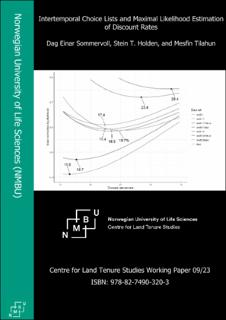| dc.contributor.author | Sommervoll, Dag Einar | |
| dc.contributor.author | Holden, Stein T. | |
| dc.contributor.author | Tilahun, Mesfin | |
| dc.date.accessioned | 2023-12-19T14:06:02Z | |
| dc.date.available | 2023-12-19T14:06:02Z | |
| dc.date.issued | 2023-12 | |
| dc.identifier.isbn | 978-82-7490-320-3 | |
| dc.identifier.uri | https://hdl.handle.net/11250/3108239 | |
| dc.description.abstract | The experiments designed to estimate real-life discount rates in intertemporal choice often rely on ordered choice lists, where the list by design aims to capture a switch point between near- and far-future alternatives. Structural models like a Samuelson discounted utility model are often fitted to the model using maximal likelihood estimation. We show that dominated tasks, that is, choices that do not define the switch point, may bias ML estimates profoundly and predictably. More (less) dominated near future tasks give higher (lower) discount rates. Simulation analysis indicates estimates may remain largely unbiased using switch point-defining tasks only. | en_US |
| dc.language.iso | eng | en_US |
| dc.publisher | Norwegian University of Life Sciences, Ås | en_US |
| dc.relation.ispartofseries | CLTS Working paper;09/23 | |
| dc.rights | Attribution-NonCommercial-NoDerivatives 4.0 Internasjonal | * |
| dc.rights.uri | http://creativecommons.org/licenses/by-nc-nd/4.0/deed.no | * |
| dc.subject | Choice lists | en_US |
| dc.subject | Time discounting | en_US |
| dc.subject | Maximal likelihood estimation | en_US |
| dc.title | Intertemporal Choice Lists and Maximal Likelihood Estimation of Discount Rates | en_US |
| dc.type | Working paper | en_US |
| dc.source.pagenumber | 20 | en_US |

